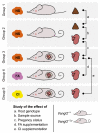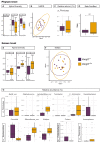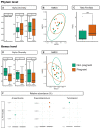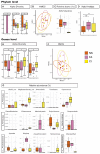Analysis of Gut Characteristics and Microbiota Changes with Maternal Supplementation in a Neural Tube Defect Mouse Model
- PMID: 38068802
- PMCID: PMC10708240
- DOI: 10.3390/nu15234944
Analysis of Gut Characteristics and Microbiota Changes with Maternal Supplementation in a Neural Tube Defect Mouse Model
Abstract
Adequate nutrient supply is crucial for the proper development of the embryo. Although nutrient supply is determined by maternal diet, the gut microbiota also influences nutrient availability. While currently there is no cure for neural tube defects (NTDs), their prevention is largely amenable to maternal folic acid and inositol supplementation. The gut microbiota also contributes to the production of these nutrients, which are absorbed by the host, but its role in this context remains largely unexplored. In this study, we performed a functional and morphological analysis of the intestinal tract of loop-tail mice (Vangl2 mutants), a mouse model of folate/inositol-resistant NTDs. In addition, we investigated the changes in gut microbiota using 16S rRNA gene sequencing regarding (1) the host genotype; (2) the sample source for metagenomics analysis; (3) the pregnancy status in the gestational window of neural tube closure; (4) folic acid and (5) D-chiro-inositol supplementation. We observed that Vangl2+/Lp mice showed no apparent changes in gastrointestinal transit time or fecal output, yet exhibited increased intestinal length and cecal weight and gut dysbiosis. Moreover, our results showed that the mice supplemented with folic acid and D-chiro-inositol had significant changes in their microbiota composition, which are changes that could have implications for nutrient absorption.
Keywords: Wnt/PCP; folic acid; inositol; loop-tail; metagenomics; microbiota; neural tube defects; pregnancy; prevention.
Conflict of interest statement
The authors declare no conflict of interest.
Figures





Similar articles
-
D-chiro-inositol is more effective than myo-inositol in preventing folate-resistant mouse neural tube defects.Hum Reprod. 2002 Sep;17(9):2451-8. doi: 10.1093/humrep/17.9.2451. Hum Reprod. 2002. PMID: 12202440
-
Association of embryonic inositol status with susceptibility to neural tube defects, metabolite profile, and maternal inositol intake.FASEB J. 2024 Jun 15;38(11):e23738. doi: 10.1096/fj.202400206R. FASEB J. 2024. PMID: 38855924
-
High levels of iron supplementation prevents neural tube defects in the Fpn1ffe mouse model.Birth Defects Res. 2017 Jan 30;109(2):81-91. doi: 10.1002/bdra.23542. Birth Defects Res. 2017. PMID: 28008752 Free PMC article.
-
What are the molecular mechanisms of neural tube defects?Bioessays. 1998 Jan;20(1):6-8. doi: 10.1002/(SICI)1521-1878(199801)20:1<6::AID-BIES3>3.0.CO;2-T. Bioessays. 1998. PMID: 9504042 Review.
-
Modeling anterior development in mice: diet as modulator of risk for neural tube defects.Am J Med Genet C Semin Med Genet. 2013 Nov;163C(4):333-56. doi: 10.1002/ajmg.c.31380. Epub 2013 Oct 4. Am J Med Genet C Semin Med Genet. 2013. PMID: 24124024 Free PMC article. Review.
References
-
- Berry R.J., Li Z., Erickson J.D., Li S., Moore C.A., Wang H., Mulinare J., Zhao P., Wong L.Y., Gindler J., et al. Prevention of neural-tube defects with folic acid in China. China-U.S. Collaborative Project for Neural Tube Defect Prevention. N. Engl. J. Med. 1999;341:1485–1490. doi: 10.1056/NEJM199911113412001. - DOI - PubMed
MeSH terms
Substances
Grants and funding
- DOC_01701/Consejería de Transformación Económica, Industria, Conocimiento y Universidades; Junta de Andalucía
- P20_01267/Consejería de Transformación Económica, Industria, Conocimiento y Universidades; Junta de Andalucía
- RH-0033-2020/Consejería de Salud y Bienestar Social; Junta de Andalucía
- C-0025-2018/Consejería de Salud y Bienestar Social; Junta de Andalucía
- EF- 0084-2016/Consejería de Salud y Bienestar Social; Junta de Andalucía
- 050561/Consejo Superior de Investigaciones Científicas; Ministerio de Ciencia e Innovación
- PI17/00693/Instituto de Salud Carlos III (ISCIII) and co-funded by the European Union
- PI20/00769/Instituto de Salud Carlos III (ISCIII) and co-funded by the European Union
- 202220/095/Consejo Superior de Investigaciones Científicas; Ministerio de Ciencia e Innovación
LinkOut - more resources
Full Text Sources
Medical

